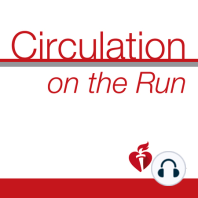18 min listen
Circulation September 21, 2021 Issue
ratings:
Length:
25 minutes
Released:
Sep 20, 2021
Format:
Podcast episode
Description
This week's episode features author Benjamin Levine and Guest Editor Walter Paulus as they discuss the article "One-Year Committed Exercise Training Reverses Abnormal Left Ventricular Myocardial Stiffness in Patients with Stage-B HFpEF." Dr. Greg Hundley: Well, welcome listeners. This is the September 21st podcast for Circulation on the Run. Sadly, I'm without Carolyn today, but I am your host today, Dr. Greg Hundley, associate editor and director of the Pauley Heart Center at VCU Health in Richmond, Virginia. Dr. Greg Hundley: Our feature discussion today is really interesting. It's from Dr. Ben Levine, and he's evaluating the utility of exercise training and actually trying to reverse abnormal left ventricular myocardial stiffness in individuals that have stage B, it's a very early heart failure and preserved ejection fraction. But before we get to that, let's grab a cup of coffee and we're going to work through some of the other articles in this issue. Dr. Greg Hundley: So the first one comes to us from Göran Bergström from University of Gothenburg in Sweden. He and his team used coronary computed tomography angiography or CCTA to determine the prevalence, severity and characteristics of coronary atherosclerosis and its association to coronary artery calcification scores in a general population of greater than 25,000 individuals all aged 50 to 64 years and without known coronary heart disease. It really comes to us from the Swedish CArdioPulmonary BioImage Study or SCAPIS. Well, Carolyn would ask me that is a really large study, and what did they find? Well, let's get to the results. Dr. Greg Hundley: So using CCTA to detect silent coronary atherosclerosis, the investigators showed that any coronary atherosclerosis was actually quite common, 42% of individuals and significant stenosis of greater than 50% was less common, only 5% of individuals. More severe forms were rarely found, only 1.9% in this very large, random sample of middle-aged individuals. Dr. Greg Hundley: Now disease onset was delayed by 10 years in women and a higher prevalence of coronary atherosclerosis was observed with higher age and accumulation of risk factors. Interestingly, CCTA detected atherosclerosis increased with an increasing coronary artery calcium score. All those with a high CAC score of greater than 400 had atherosclerosis and 45% had significant stenosis. 5.5% of those with no coronary artery calcification had atherosclerosis and 0.4% had significant stenosis. So although there was a strong association with high coronary artery calcium scores and significant stenosis, atherosclerosis was not excluded in those with zero coronary artery calcification especially in those with high baseline risk. Dr. Greg Hundley: Well, our second article comes to us from the world of preclinical science and it's from Dr. Nathan Palpant from the University of Queensland. So the article pertains to ischemia reperfusion injury, and it's one of the major risk factors implicated in morbidity and mortality associated with cardiovascular disease. Now during cardiac ischemia, the buildup of acidic metabolites results in decreased intracellular and extracellular pH that can reach as low as 6 to 6.5, and the resulting tissue acidosis exacerbates ischemia injury and significantly impacts cardiac function. Dr. Greg Hundley: So the authors today use genetic and pharmacologic methods to investigate the role of acid-sensing ion channel 1a or ASIC1a, we'll call it from now, in cardiac ischemia reperfusion injury at the cellular and whole organ level. Human induced pluripotent stem cell-derived cardiomyocytes as well as ex vivo and in vivo models of ischemia reperfusion injury were used to test the efficacy of ASIC1a inhibitors as pre-imposed conditioning therapeutic agents. Dr. Greg Hundley: So what did the authors find in this study? Well, they demonstrated for the first time that acid-sensing ion channel 1a or that ASIC1a mediates cardiac ischemia reperfusion injury. The au
Released:
Sep 20, 2021
Format:
Podcast episode
Titles in the series (100)
Circulation January 23, 2018 Issue by Circulation on the Run
